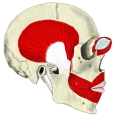頬 筋 ( きょうきん、英:buccinators muscle )
・ 概 要 |
・ 作 用 |
・ イラスト掲載サイ |
|
・ イラスト |
・ 神経 / 脈管 |
||
・ 起始 / 停止 |
・ Wikipedia |
![]()
・頭部の表情筋のうち口唇と頬周辺の筋肉の一つで、筋肉の一方が皮膚に付着している皮筋である。

![]()
![]()
【 起 始 】:
・上顎骨の歯槽隆起の外側面 ・下顎骨の頬筋稜および翼突下顎縫線(蝶形骨の翼突鈎と下顎骨の頬筋稜との間に張る結合組織性線条)
「船戸和弥の解剖学テキスト」では以下のような解説をしている。
「この筋は上下両顎の歯槽突起の外面で第2と第3の大臼歯のある範囲からならびに頬咽頭縫線Rhaphe bucipharyngicaという1本の靱帯条から馬蹄形の線をえがいて起る.」
【 停 止 】:
・口角において口輪筋に移行する。
「船戸和弥の解剖学テキスト」では以下のような解説をしている。
「上方の線維は前下方に,下方の線維は前上方に口角に向って走り,そこで交叉して,下方の線維は上唇に,上方の線維は下唇に達する.上下両唇の中に入っていった筋束は口輪筋の主要な基礎をなしている.常にいくつかのオトガイ筋束Fasciculus mentalisという筋束がオトガイ筋の起始する部分のすぐそばで,且つ小臼歯のある範囲で下顎骨の歯槽突起に付着しており,その一部はオトガイ筋に移行し,またよく発達しているときには頚部の皮膚にも達している。」
![]()
「日本人体解剖学 (上巻)」では以下のような解説になっている。
「口角を外側に引き口裂を閉じる。頬が満たされた状態では口腔内容を吹き出させる。(例:ラッパを吹くときなど)」
![]()
・ 神 経 : ・顔面神経の頬骨枝
・ 脈 管 :
The buccinator (/ˈbʌksɪneɪtər/[2][3]) is a thin quadrilateral muscle occupying the interval between the maxilla and the mandible at the side of the face. It forms the anterior part of the cheek or the lateral wall of the oral cavity.[4]
Structure[edit]
It arises from the outer surfaces of the alveolar processes of the maxilla and mandible, corresponding to the three pairs of molar teeth and in the mandible, it is attached upon the buccinator crest posterior to the third molar;[5] and behind, from the anterior border of the pterygomandibular raphe which separates it from the constrictor pharyngis superior.
The fibers converge toward the angle of the mouth, where the central fibers intersect each other, those from below being continuous with the upper segment of the orbicularis oris, and those from above with the lower segment; the upper and lower fibers are continued forward into the corresponding lip without decussation.
Innervation[edit]
Motor innervation is from the buccal branch of the facial nerve (cranial nerve VII). Sensory innervation is supplied by the buccal branch (one of the muscular branches) of the mandibular part of the trigeminal (cranial nerve V).[6]
Function[edit]
Its purpose is to pull back the angle of the mouth and to flatten the cheek area, which aids in holding the cheek to the teeth during chewing. This action causes the muscle to keep food pushed back on the occlusal surface of the posterior teeth, as when a person chews. By keeping the food in the correct position when chewing, the buccinator assists the muscles of mastication.[4]
It aids whistling and smiling, and in neonates it is used to suckle.
【 語 句 】
・: ・: ・: ・: ・: ・: ・: ・: ・: ・: ・: ・: ・: ・: ・: ・: ・: ・: ・: ・: ・: ・: ・: ・: ・: ・: ・: ・: ・: ・: ・: ・: ・: ・: ・:
![]()
・イラストを掲載しているサイト②



